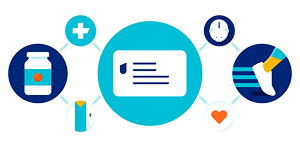The average woman has about a 1 in 8 chance of developing breast cancer in her life. And more than a quarter-million women in the United States are diagnosed with breast cancer every year.
The good news is that breast cancer is highly treatable and survivable. When breast cancer is caught early (before it’s spread beyond the breast), the 5-year survival rate is 99%. And regular screenings, like mammograms, are the best way to catch it early.
You might have a lot of questions about mammograms and your breast cancer risk. Here are some answers to help put your mind at ease.
Ask yourself: If you got sick and had to miss work, would you have enough to cover your bills? That’s where critical illness insurance can help. Explore it today.
What is a mammogram?
A mammogram is the most common method of screening for breast cancer. It’s an X-ray picture of the breast that can detect cancer in its earliest stages. A mammogram can’t prevent you from developing cancer. But it can catch it early when it’s easier to treat. And the earlier you detect breast cancer, the more likely you are to survive and recover from it.
How often should I get a mammogram?
Your family doctor or ob-gyn will talk to you about your breast cancer screening options. Most women won’t need to get a mammogram until they are 50 years old. That’s because breast cancer is less common in younger women. Only about 10% of breast cancer cases happen in women under 45 years old.
The U.S. Preventive Services Task Force recommends that women ages 50 to 74 get a mammogram every 2 years. If you’re 75 or older, talk to your doctor about whether to continue getting mammograms.
If you’re under 50, it’s a good idea to talk to your doctor about your risk level for breast cancer. They may recommend getting a mammogram as early as age 40 if they think you are at higher risk. Factors that increase your risk of breast cancer include:
- Being overweight or having obesity
- Drinking alcohol
- Family history of breast cancer or ovarian cancer (more on this below)
- Having your first pregnancy after age 30, or never having a full-term pregnancy
- Not being physically active
- Starting your menstrual cycle early (before age 12) or starting menopause late (after age 55)
What if I have a family history of breast cancer?
Breast cancer tends to run in families. You may be at higher risk of breast cancer if your mother, sister or daughter has had breast cancer. You may also have a higher risk if several more distant relatives have had it (such as aunts, grandmothers or cousins) or if any men in your family have had it.
If that’s the case for you, your doctor will likely recommend starting mammograms at an earlier age and getting them done more often. They may also recommend genetic testing. Using a small sample of DNA from your blood or saliva, doctors can look for certain genetic changes (mutations) that are known to increase the risk of breast cancer.
Your doctor will come up with a personalized prevention and screening plan for you based on the results.
Is a mammogram covered by insurance?
Your health insurance will most likely cover the cost of your mammogram. A mammogram is covered as preventive care under the Affordable Care Act (ACA). That means that any health plan that meets ACA guidelines must cover routine mammograms at no cost to you.
A serious medical condition, like cancer, can quickly bust your health care budget. Learn how critical illness insurance can help you balance it again.
What happens during a mammogram?
Knowing what to expect during your mammogram can make it less nerve-racking. Here’s a step-by-step overview of the process from Hala Mazin, M.D. She’s a radiologist and breast imaging fellow at MD Anderson Cancer Center in Houston.
- You’ll need to undress from the waist up (you might want to wear a skirt or pants instead of a dress to the appointment).
- You’ll stand in front of an X-ray machine, and a technician will place your breast between 2 plates. You’ll feel some pressure as the 2 plates press down on your breast. This helps flatten the breast tissue so it’s easier to find signs of cancer.
- Once your breast is in position, they’ll take a picture, which takes just a few seconds.
- They’ll reposition that breast and take another picture from a different angle.
- Then they’ll repeat the process with the other breast.
The whole process takes about 20 minutes, says Dr. Mazin. You may feel uncomfortable, and parts of it can be painful. Your technician will try to make it as quick and painless as possible. But don’t hesitate to speak up if you’re feeling a lot of pain.
Ready to explore insurance plans where you live?
How should I prepare for my mammogram?
There’s not much you need to do to prepare for your mammogram. Your doctor can help you find a facility where you can get a mammogram and help you schedule your appointment.
When scheduling, Dr. Mazin recommends avoiding the time around your period when your breasts might be more tender. That can help make the mammogram less painful.
Here are Dr. Mazin’s other tips for the day of your mammogram:
- Bring in any past records or mammograms for comparison.
- Review your family history and let the technician know if you have an increased risk of breast cancer.
- Let the technician know of any recent weight loss/weight gain or any other changes in your health.
- Wear a top/bra that is easy to take on and off.
- Don’t apply deodorant, antiperspirant, powders, lotions, creams or perfumes under your arms or on/under your breasts.
When will I get my results?
A radiologist will review the images from your mammogram and report them to you and your doctor. It can take a few weeks to hear about the results. If you don’t hear about them within 30 days, you might want to call the facility or your doctor.
If you end up with an abnormal result, don’t panic. That does not always mean that you have cancer. Your doctor will likely want to do some follow up tests to get a clearer picture. They may also refer you to a breast specialist or surgeon to help diagnose the problem or rule out breast cancer.
It is okay to be nervous and have questions about a new medical procedure. If you have more questions, don’t hesitate to ask your doctor or any other provider on your team. The important thing is getting your mammogram when recommended.
Imagine a check, paid directly to you or your provider, to help with medical expenses if you had a cancer diagnosis. Explore supplemental critical illness insurance today, or call a licensed insurance agent at 1-844-211-7730.
For informational purposes only. This information is compiled by UnitedHealthcare and does not diagnose problems or recommend specific treatment. Services and medical technologies referenced herein may not be covered under your plan. Please consult directly with your primary care physician if you need medical advice.
Sources:
American Cancer Society. “Key statistics for breast cancer.” January 12, 2023. Retrieved from https://www.cancer.org/cancer/breast-cancer/about/how-common-is-breast-cancer.html
Centers for Disease Control and Prevention. “United States Cancer Statistics: Changes over time: Female breast.” Retrieved from https://gis.cdc.gov/Cancer/USCS/#/Trends/ Accessed March 7, 2023
Centers for Disease Control and Prevention. “What are risk factors for breast cancer?” September 26, 2022. Retrieved from https://www.cdc.gov/cancer/breast/basic_info/risk_factors.htm
Centers for Disease Control and Prevention. “What is a mammogram?” September 26, 2022. Retrieved from https://www.cdc.gov/cancer/breast/basic_info/mammograms.htm
National Cancer Institute. “Cancer stat facts: Female breast cancer.” Retrieved from https://seer.cancer.gov/statfacts/html/breast.html Accessed March 7, 2023
U.S. Preventive Services Task Force. “Breast cancer: Screening.” Retrieved from https://www.uspreventiveservicestaskforce.org/uspstf/recommendation/breast-cancer-screening Accessed March 13, 2023.
U.S. Office of Women’s Health. “99 percent survival rate for breast cancer caught early.” October 6, 2022. Retrieved from https://www.womenshealth.gov/blog/99-percent-survival-rate-breast-cancer-caught-early
Compliance code:
49707-X-0523











